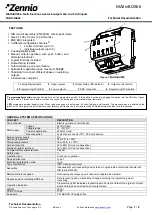
Module Operation
506
SPNU563A – March 2018
Copyright © 2018, Texas Instruments Incorporated
CPU Compare Module for Cortex-R5F (CCM-R5F)
13.2.3.2.1 Compare Match Test
Since the comparison is done against the clamped values, and all compared signals are clamped to zero,
only one test pattern is applied for the compare match test. A pattern of all-zeros are applied for the
compare match test. The test will take one cycle. If the compare unit produces a compare mismatch then
the self-test error flag is set, the self-test error signal is generated, and the Compare Match Test is
terminated.
13.2.3.2.2 Compare Mismatch Test
During the Compare Mismatch Test, the number of test patterns is equal to the number of bus signals on
the checker CPU to be monitored. There are a total of 6 signals being monitored on the checker CPU's
level 2 interface and hence it takes 6 test patterns for the mismatch test. The mismatch test will take a
total of 6 cycles to complete. An all 0's test vector is applied to the CCM-R5F’s but with one bit flipped
starting from signal position 0. The un-equal vector will cause the CCM-R5F to expect a compare
mismatch at signal position 0, if the CCM-R5F logic is working correctly. If, however, the CCM-R5F logic
reports a compare match, the self-test error flag is set, the self-test error signal is asserted, and the
Compare Mismatch Test is terminated.
This Compare Mismatch Test algorithm repeats in a domino fashion with the next signal position flipped
while forcing all other signals to logic level 0. This sequence is repeated until every inactivity monitor
signal position is verified on the checker CPU .
shows the sequence of Compare Mismatch Test. There is no error signal sent to ESM if the
expected errors are seen with each pattern.
Table 13-6. Checker CPU Inactivity Monitor Compare Mismatch Test
Signal Position
5
4
3
2
1
0
Cycle
0
0
0
0
0
1
0
0
0
0
0
1
0
1
0
0
0
1
0
0
2
0
0
1
0
0
0
3
0
1
0
0
0
0
4
1
0
0
0
0
0
5
13.2.3.3 Error Forcing Mode
In error forcing mode, a test pattern of all 1's is applied to the check CPU's compare logic to force an error
in the compare error output signal of the compare unit. The ESM error flag “CCM-R5F - CPU1 AXIM Bus
Inactivity failure” is expected after the error forcing mode completes. As a side effect, the “CCM-R5F self-
test error” flag is also asserted whenever the CPU compare error is asserted.
The error forcing mode takes one cycle to complete. Hence, the failing signature is presented for one
clock cycle. After that, the mode is automatically switched to active compare mode. The key register
(MKEY3) will indicate the active compare mode once it is switched to active compare mode. During the
one cycle required by the error forcing test, the checker CPU Inactivity Monitor is deactivated. User should
expect the ESM to trigger a response (report the CCM-R5F fail). If no error is detected by ESM, then a
hardware fault is present.
13.2.3.4 Self-Test Error Forcing Mode
In self-test error forcing mode, an error is forced at the self-test error signal. The compare unit is still
running in active compare mode and the key is switched to active compare after one clock cycle. The
ESM error flag “CCM-R5F - self-test” is expected after the self-test error forcing mode completes. Once
the expected errors are seen, the application can clean the error through the ESM module.
















































